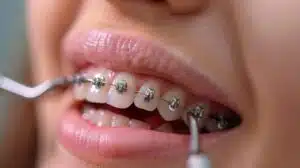The cost of traditional braces covers far more than the metal brackets you see on your teeth. At Orthodontic Specialists of Palm Coast, every treatment plan includes services and materials designed to deliver safe, lasting results. That’s why the price of braces can vary so much from one patient to another. Materials are only the starting point. Brackets, wires, bands, and retainers all work together to guide teeth into alignment. Durable and precise components are chosen to ensure both comfort and effectiveness.
The largest investment is the orthodontist’s expertise. With over 25 years of experience, the team begins with a detailed diagnosis and provides carefully timed adjustments. Each visit builds on the last, ensuring steady and predictable progress toward your best smile. Regular monitoring is also part of the process. Most patients return for frequent visits, which are essential for tracking movement, making corrections, and staying on schedule. Treatment length plays a big role in cost. A simple alignment may take about a year, while more complex cases can extend two years or longer. Naturally, more appointments and adjustments increase the overall investment.
In short, the price of braces reflects the complete process — from planning and materials to expert care. If you’ve been wondering what is the cost of traditional metal braces, the answer depends on these many moving parts.
How Much Do Traditional Braces Cost? National Price Averages
If you’re looking for a general idea of what braces cost, national data offers a helpful starting point. Across the U.S., the average cost of traditional braces typically ranges from $3,000 to $7,000, depending on case complexity and the type of braces used.
Traditional metal braces are often the most affordable option compared to ceramic braces or clear aligners. Still, several factors can shift the price up or down, such as treatment length, case difficulty, and location.
For example, patients in large urban areas with a higher cost of living often pay more, while those in rural or suburban communities may see lower fees. Orthodontists who use advanced technology or hold additional certifications may also charge slightly more — reflecting their expertise and the tools they use to deliver more comfortable, precise outcomes.
At Orthodontic Specialists of Palm Coast, fees are explained clearly before treatment begins. The team combines decades of experience with advanced digital tools such as iTero® scanning and CBCT imaging. These innovations, paired with expert care, give patients confidence they are receiving high-quality treatment that justifies the investment.
These national averages provide a helpful benchmark, but the most accurate way to know what is the cost of traditional metal braces in Palm Coast is to schedule a consultation with our team. That way, we can assess your unique needs and provide a personalized estimate.
Traditional Metal Braces Cost vs. Invisalign: What’s Cheaper in Palm Coast?
One of the most common questions patients in Palm Coast ask is whether traditional braces or Invisalign will be the more affordable choice. Both treatments can deliver excellent results, but the costs and trade-offs are different.
In most cases, traditional braces are less expensive upfront. The brackets and wires are more cost-effective to produce than Invisalign’s series of custom-made aligners. Because of this, braces often end up being the slightly cheaper option when treating similar levels of alignment issues.
That said, Invisalign can sometimes require fewer office visits and, in certain cases, a shorter overall timeline. For adults balancing busy schedules, this convenience may help offset part of the higher price.
Cost isn’t the only deciding factor. Many adults choose Invisalign for its nearly invisible appearance, while braces remain the go-to option for younger patients or those needing more complex adjustments.
Ultimately, the difference comes down to your specific case and priorities. Patients in Palm Coast who are comparing braces and Invisalign often find it helpful to look at not just the numbers, but also lifestyle, appearance, and treatment reliability before deciding which path fits best.
What Is the Cost of Traditional Metal Braces for Kids vs. Adults?
The cost of traditional braces often depends on age. Children and adults usually have different orthodontic needs that affect treatment and price.
For children, treatment often begins during growth. This allows orthodontists to guide jaw development and tooth alignment. When braces are placed at the right stage, treatment can be shorter. However, if early interceptive treatment is needed — such as during mixed dentition with baby and permanent teeth — the overall cost may be higher because care is delivered in two phases.
For adults, treatment is often more complex. Since growth is complete, teeth usually move more slowly. Issues like crowding, bone loss, or past extractions may also add to the cost and timeline. Adults often require longer treatment periods, which can increase the number of visits and adjustments.
In general, braces for kids may cost less in simple cases, while adult treatment can be more involved. Still, every situation is unique. For families in Palm Coast, the final price depends on timing, case complexity, and the orthodontist’s approach to care.
Traditional Metal Braces Cost vs. Value: Are They Worth It?
When considering orthodontic options, many patients wonder whether traditional braces are a smart long-term investment. The answer often depends on what matters most — cost, effectiveness, or convenience.
Traditional metal braces remain one of the most dependable tools for correcting even complex alignment issues. They allow orthodontists to precisely guide tooth movement, producing predictable results that lead to better function, improved oral hygiene, and fewer dental problems later in life.
Unlike clear aligners, which can crack or be misplaced, metal brackets and wires are durable and always working. This reliability adds to their overall value, especially for teens or adults who may forget to wear aligners consistently.
So, are metal braces worth it? For most patients, the answer is yes — their durability, precision, and long-term benefits make them a smart investment in both health and confidence.
What Is the Price of Traditional Metal Braces at Orthodontic Specialists of Palm Coast?
No two orthodontic cases are exactly the same, which is why the cost of treatment can vary so widely from one patient to another. At Orthodontic Specialists of Palm Coast, pricing reflects the complexity of your case, the length of treatment, and any additional care that may be needed along the way.
Case complexity is one of the biggest factors. Severe crowding, bite misalignments, or spacing issues may require more adjustments, which can extend treatment time and increase the total cost.
Location also plays a role. Urban areas with higher overhead often have higher fees, while patients in communities like Palm Coast may find treatment more accessible compared to large metropolitan practices.
Treatment length matters as well. A straightforward case might last just over a year, while more advanced corrections can extend to two years or longer. More visits and adjustments naturally add to the overall investment.
Some patients may also need additional appliances, such as expanders, headgear, or even extractions before braces can begin. Each of these adds to the total price.
So if you’re asking what is the price of traditional metal braces, the answer goes beyond the brackets and wires. It’s shaped by your individual needs, your treatment plan, and the expert care guiding you through the process.
How Much Do Traditional Braces Cost Without Insurance in Palm Coast?
Without dental insurance, the full cost of braces becomes the patient’s responsibility. For many families, that means paying out of pocket for every stage of care — from the initial diagnosis and appliances to regular adjustments and retainers. This can feel overwhelming, but it doesn’t have to put treatment out of reach.
At Orthodontic Specialists of Palm Coast, fees are reviewed with patients before treatment begins. Flexible payment solutions are available to reduce the initial cost. Options include interest-free in-house payment plans and the ability to pay with major credit cards. The team also assists in determining whether any medical or dental benefits can apply, even without traditional dental insurance.
So, while the price of braces without insurance varies by case complexity, families in Palm Coast can move forward confidently knowing there are structured ways to spread out payments and make treatment more manageable.
Traditional Metal Braces Cost & Financing Options in Palm Coast
If paying for braces all at once isn’t feasible, you’re not alone. Many patients rely on flexible payment arrangements to make orthodontic care manageable.
At Orthodontic Specialists of Palm Coast, all treatment fees and payment options are reviewed before starting care to support informed decisions. Their team offers:
-
Customized in-house payment plans designed to fit your budget.
-
Acceptance of most major credit cards and insurance plans.
-
Assistance with filing insurance claims and paperwork to maximize benefits.
By talking through financing before treatment, you’ll avoid surprises, understand your options, and know how your plan fits into your financial picture.
Final Thoughts
By now, it’s clear there isn’t one set price for traditional braces. While many patients across the United States pay between $3,000 and $7,000, your actual cost could be higher or lower depending on your case.
What you’re really investing in is a combination of expert care, treatment time, and the complexity of your alignment needs. From early interventions in children to full orthodontic correction in adults, every treatment plan is uniquely tailored.
Other factors such as location, insurance coverage, and the need for additional appliances — also influence the final total. That’s why two patients receiving the same type of braces can end up with very different costs.
Ultimately, the price of traditional metal braces comes down to your unique needs and goals. The most reliable way to know your cost is through a consultation, where your smile can be evaluated and a personalized plan created.
Find Out What Traditional Braces Cost at Orthodontic Specialists of Palm Coast
If you’re considering braces in the area, Orthodontic Specialists of Palm Coast is here to guide you. The practice is built on the belief that orthodontic care should be accessible, transparent, and tailored to each patient. The team brings decades of experience to every case. Advanced digital technology supports precise, efficient treatment. With a focus on comfort at every visit, you’ll feel confident in expert hands.
Whether you’re just starting your research or ready to begin, a consultation is the best first step. It helps you understand your options and gives you a clear picture of costs. At this visit, you’ll receive a personalized treatment plan and a detailed quote. You’ll also get answers to common questions about financing and insurance.
Still wondering about the cost of traditional metal braces? Schedule your consultation today and take the first step toward a confident, healthy smile with a plan designed to fit your needs and lifestyle.



